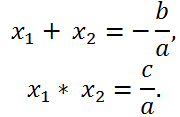Vieta's theorem establishes a connection between the coefficients of a quadratic equation and its roots, if they exist.
THE THEOREM.
If x1, x2 are the roots of the quadratic equation ax2 + bx + c = 0, then the sum of the roots is
, and the product of the roots is equal to :

For the reduced quadratic equation
x2 + px + q = 0 Vieta's theorem can be formulated quite simply:
the sum of the roots of the reduced quadratic equation is equal to the coefficient at x, taken with the inverse sign, and the product of the roots is equal to the free term:
x
1 + x
2 = - p,
x
1 * x
2 = q.
The proof of this theorem follows directly from the formulas for the roots of the quadratic equation.
The inverse theorem is also true. If the numbers x
1, x
2 are such that
x
1 + x
2 = - p,
x
1 * x
2 = q.
then these numbers are the roots of the quadratic equation
x2 + px + q = 0.
With this theorem, many quadratic equations can be easily solved without using cumbersome formulas for its roots. In addition, very often one of the roots of the equation is the number x
1 = 1 or x
1 = -1, which is easily verified by a simple substitution. Then the second root can be quickly found from the equality x
1* x
2 =
, so x
2 =
or x
2 = -
. Vieta's theorem can also be used to verify the found roots of a quadratic equation. Let's consider the application of this theorem using examples.
